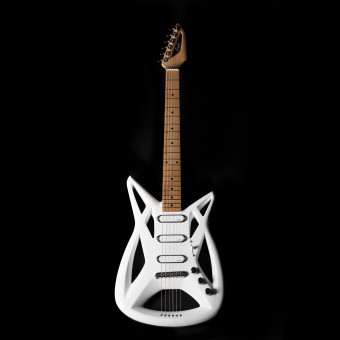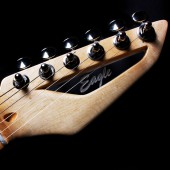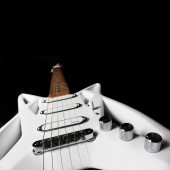
| THE AWARD |
| CATEGORIES |
| REGISTRATION |
| SUBMIT YOUR WORK |
| ENTRY INSTRUCTIONS |
| TERMS & CONDITIONS |
| PUBLICATIONS |
| DATES & FEES |
| METHODOLOGY |
| CONTACT |
| WINNERS |
| PRESS ROOM |
| GET INVOLVED |
| DESIGN PRIZE |
| DESIGN STORE |
| THE AWARD | JURY | CATEGORIES | REGISTRATION | PRESS | WINNERS | PUBLICATIONS | ENTRY INSTRUCTIONS |
Eagle Electric Guitar by David Flores Loredo |
Home > Winners > Design #55677 >Interview |
 |
|
FS: What is the main principle, idea and inspiration behind your design?
DF: The Eagle presents a lightweight, futuristic and sculptural design with a completely new design language, inspired by the Streamline and the Organic design philosophies.
FS: What has been your main focus in designing this work? Especially what did you want to achieve?
DF: I wanted to achieve the most beautiful and lightweight guitar that I could realize. In this creative process I didn’t wanted to do the same that I had seen before, because I had the feeling that something more advanced, more attractive and completely new could be done. With that feeling in mind I started to push the stablished limits with new ideas, shapes and volumes, with the objective of develop a futurist design but at the same time elegant and enough conservative to be understood as an electric guitar at first saw, without trespassing the “Most Advanced Yet Acceptable” line.
FS: What are your future plans for this award winning design?
DF: Probably take it to a serial manufacturing and offer this guitar to any guitarrist of the world.
FS: How long did it take you to design this particular concept?
DF: The project toke approximately one year from the first sketches to the final result. Anyway, I would say that it toke all my life, because I could not realize it without all my experience collected till today.
FS: Why did you design this particular concept? Was this design commissioned or did you decide to pursuit an inspiration?
DF: This design was not commissioned. It was done as a particular challenge in the way to design, build and play the best electric guitar that I could do, the guitar of my dreams.
FS: Is your design being produced or used by another company, or do you plan to sell or lease the production rights or do you intent to produce your work yourself?
DF: My main intention is to produce my work myself.
FS: What made you design this particular type of work?
DF: In this work converged three of my main passions and skills: engineering, design and guitar playing. I play the electric guitar since I was thirteen and I think that I love them since I was a child. I have been always attracted for them because of their beauty, their sound and because I love rock music. There is something coolest than an electric guitar? On the other side, I am also a passionate designer, so I found a great pleasure in the process of creation of this product from a blank paper with total creativity freedom, pushing the limits and following my own conception of beauty. Finally, as an engineer, I had the knowledge needed to take the design to the reality in a professional and accurate way. Because of all these reasons, it was a fascinating challenge to design, build and play my own guitar and I think that this project was for me simply unavoidable.
FS: Who is the target customer for his design?
DF: The target customer for this product is an experimented guitarist who plays high quality guitars but also desires a really different one, with a completely new design and high level of exclusivity, beauty and artistic value.
FS: What sets this design apart from other similar or resembling concepts?
DF: Apart from the classical guitar icons, which have not almost changed from the 50’s and 60’s there have been hundreds of futuristic electric guitar designs. Nevertheless, in my opinion, they are usually unbalanced and excessively futuristic. The Eagle is differentiated from these similar concepts because it is balanced, beautiful and elegant besides its clearly futuristic and defiant projection. Beyond its lightness and sound quality, it has a new fluid and sculptural design language that gives it a unique identity and a powerful presence.
FS: How did you come up with the name for this design? What does it mean?
DF: The name Eagle came to me at a very early stage of the design process and from the first moment I considered that it was a beautiful and attractive name.
FS: Which design tools did you use when you were working on this project?
DF: The design started from concept sketches on a blank paper and continued with Photoshop, complete Solidworks CAD modeling, rendering with Autodesk Showcase and fabrication with a CNC machine.
FS: What is the most unique aspect of your design?
DF: The most unique aspect is its clearly differentiated design.
FS: Who did you collaborate with for this design? Did you work with people with technical / specialized skills?
DF: Yes, I collaborated closely with Eduardo López and Rubén Bada. Eduardo López, further than being one of my best friends, is expert working with CNC machines and he has worked hard and highly motivated manufacturing this guitar. Rubén Bada is a professional musician and luthier and he has worked on the guitar painting, polishing and final adjustment. Finally, Palmira Escobar is professional photographer and she shooted the final studio pictures. Without their talent, this project would have been impossible.
FS: What is the role of technology in this particular design?
DF: I would say that it has been absolutely essential. This guitar has been designed through a 3D software and manufactured by a CNC machine and I think that it could not have been done without this quality and precision in any other way.
FS: Is your design influenced by data or analytical research in any way? What kind of research did you conduct for making this design?
DF: This project implied a deep research in the electric guitar engineering techniques in order to obtain high quality standards in sound, ergonomics and playability. Likewise, my previous experience developing organic porcelain lamps inspired by nature voronoi patterns, made me internalize the organic beauty of their shapes and apply them to this guitar. Finally, I studied in depth many of the main Streamline artworks to project their fascinating sense of flow and speed to this design.
FS: What are some of the challenges you faced during the design/realization of your concept?
DF: First of all, the main challenge was to achieve a really new, attractive and lightweight design. With that clear objective in mind I decided to use a futuristic and beautiful organic-streamlined design language, which was for me a perfect combination. It needed a continuous effort in order to obtain a proportioned and elegant shape and to maintain at the same time an accurate balance between all its aesthetic characteristics: aggressiveness vs elegance, fluidity and softness vs speed and sharpness, futurism vs classicism. The main design lines were decided in a very early stage, but the challenge continued to the final detailed engineering in the process of the integration all the hardware components in small spaces and the adaptation to the real ergonomics without modifying the global design, in order to keep the flavor and the essence of the first sketches. Finally, the manufacturing process supposed another challenge in almost all the stages because the three-dimensional surfaces and concavities added quite more complexity and unexpected difficulties than in a common electric guitar.
FS: How did you decide to submit your design to an international design competition?
DF: Because it is always a pleasure to challenge at the highest level and I considered that this guitar was able to do it.
FS: What did you learn or how did you improve yourself during the designing of this work?
DF: A project like this, which involves a complete creation process, always makes you improve yourself in many different skills. Nevertheless, principally I learned a lot about electric guitars design and manufacturing.
FS: Thank you for providing us with this opportunity to interview you.
A' Design Award and Competitions grants rights to press members and bloggers to use parts of this interview. This interview is provided as it is; DesignPRWire and A' Design Award and Competitions cannot be held responsible for the answers given by participating designers.
| SOCIAL |
| + Add to Likes / Favorites | Send to My Email | Comment | View Press-Release | Translations |





